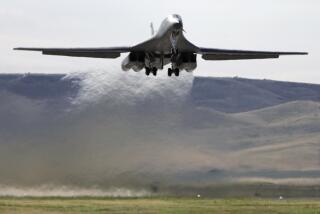Air Force to modify F-22 following fatal crash
- Share via
The Air Force will modify the handle that engages the emergency oxygen system in its entire fleet of F-22 Raptor fighter jets after a report found that it played a role in a crash that killed one of its top aviators.
The changes come as Anna Haney, the pilot’s widow, filed a wrongful-death lawsuit againstLockheed Martin Corp.and subcontractors that designed and built the nation’s most expensive fighter jet.
Capt. Jeff Haney, 31, died when his F-22 crashed in the Alaskan wilderness in November 2010.
In her suit, Anna Haney contends that the F-22 is “unreasonably defective” and that the oxygen-generation system, environmental-control system and other life-support systems were responsible for her husband’s death.
The lawsuit is just the latest blemish for the controversial F-22, which the Air Force asserts is its most advanced fighter jet. The plane has been in service since 2005 yet has never been used in combat in Iraq, Afghanistan or Libya.
“One of the problems that was found with the emergency oxygen handle is that it’s in a difficult place to get to in the dark,” said John Noonan, aide to Rep. Howard P. “Buck” McKeon (R-Santa Clarita), chairman of the House Armed Services Committee. “So the Air Force is doing some research on making adjustments to its location.”
The Air Force confirmed in a statement that about 200 handles, costing $47 each, have been delivered, including spares. The new handles have already been installed in the jets at Joint Base Elmendorf-Richardson in Alaska, where Haney was based, the Air Force said.
Haney’s inability to pull the handle during his fatal accident was one of the issues cited in an accident investigation report released by the Air Force in December.
In a detailed, minute-by-minute account, investigators found that Haney’s oxygen supply was stopped automatically after the onboard computers detected an air leak in the engine bay. The aircraft system shut down the oxygen system to protect itself from further damage, as designed.
To save himself and the plane, Haney, wearing bulky cold-weather gear, should have leaned over and, with a gloved hand, pulled a green ring that was under his seat beside his left leg to engage the emergency system, the report said.
In the end, the Air Force blamed the accident on Haney’s “channelized attention” to get oxygen through his mask instead of engaging the emergency system, which led to factors that contributed to the crash, the report said.
In her lawsuit, Haney’s widow contends that the plane was “designed, manufactured, distributed and sold with a dangerous and defective backup oxygen system, which could only be activated manually, and whose manual activation mechanism was located underneath and behind the pilot.”
The suit said the handle’s location was “in an area impossible for a pilot to reach while he or she maneuvered the sophisticated aircraft at speeds exceeding the speed of sound and while he or she experienced forces many times the force of gravity.”
Lockheed declined to answer questions about the suit, which was filed in Illinois state court in Chicago. Instead, the company issued a statement denying the allegations and announcing it planned to fight the accusations.
“The loss of the pilot and aircraft in November 2010 was a tragic event, and we sympathize with the family for their loss,” the statement said. “We are aware that a complaint that makes a variety of claims associated with the accident has been filed with the court in Cook County, Ill. We do not agree with those allegations.”
Other contractors that work on the F-22 — such asBoeing Co.,Honeywell International Inc.and Pratt & Whitney — wouldn’t answer questions involving the pending litigation.
Over the years, F-22 pilots have reported dozens of incidents in which the jet’s oxygen systems weren’t feeding them enough air, causing wooziness. This issue led to the grounding of the entire fleet last year for nearly five months.
An independent scientific advisory board working under the direction of the Air Force studied safety issues on the plane. Although the report has not become public, Air Force Chief of Staff Gen. Norton A. Schwartz said last month that the advisory board did not find a cause of the oxygen problems. Still, the Air Force decided the planes were safe to return to the sky.
“We have not identified a specific engineering fault,” Schwartz said in a speech sponsored by the Center for Strategic and International Studies in Washington, “but a number of ways that we can assure that adequate oxygen, in a very high-performance airplane that operates over a very extensive altitude band, protects the operators and maintains their physiological capacity to rock and roll.”
Since the jets returned to service in mid-September, the Air Force said, there have been nine incidents in which F-22 pilots during flight reported symptoms of hypoxia — a condition that can bring on nausea, headaches, fatigue or blackouts when the body is deprived of oxygen. Four occurred last month.
According to the Air Force, each of the sleek, diamond-winged aircraft cost $143 million. Counting upgrades, research and development costs, the U.S. Government Accountability Office estimates that each F-22 cost U.S. taxpayers $412 million.
More to Read
Sign up for Essential California
The most important California stories and recommendations in your inbox every morning.
You may occasionally receive promotional content from the Los Angeles Times.











